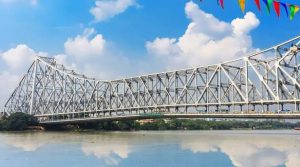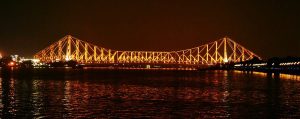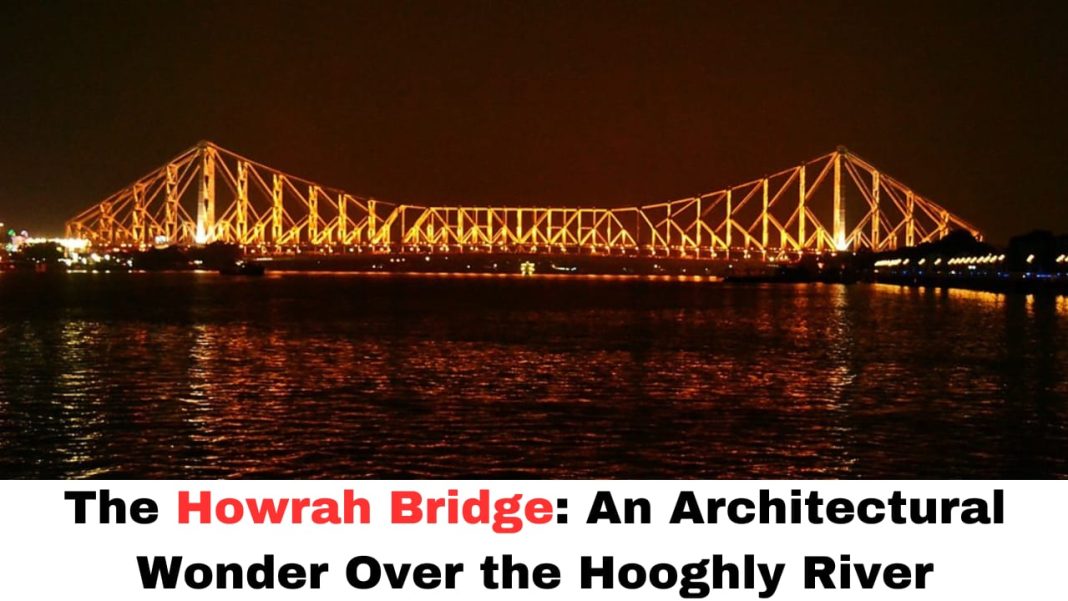Digital News Guru Kolkata Desk:
Howrah Bridge: The Icon of Kolkata
The Howrah Bridge, one of the most iconic landmarks in India, stands as a testament to Kolkata’s rich history, engineering ingenuity, and cultural significance. Spanning the Hooghly River, it connects the city of Kolkata with the Howrah district and serves as an essential lifeline for millions of people every day. More than just a bridge, it is a symbol of Kolkata’s resilience and vibrancy.
Historical Background
The idea for a permanent bridge across the Hooghly River dates back to the late 19th century, but it wasn’t until the early 20th century that the need for a new bridge became urgent. The original pontoon bridge that connected Howrah and Kolkata was becoming inadequate due to the increasing traffic volume and the growing importance of the region as an economic hub. By 1917, the pontoon bridge collapsed, prompting the British colonial government to consider the construction of a new, more robust structure.

The construction of the Howrah Bridge began in 1936, and after years of effort, it was completed in 1943. The bridge was designed by the British firm Braithwaite, Burn & Jessop Construction Company. At the time of its completion, the Howrah Bridge was the longest cantilever bridge in the world, with a span of 655 meters (2,150 feet). The bridge’s construction was a marvel of engineering, as it was built without the use of nuts and bolts, using rivets to join the steel segments.
Architecture and Design
The Howrah Bridge is a cantilever bridge, meaning that it has no central support and relies on its outward projections from both banks to bear the weight. This design was chosen to minimize the number of supports required in the riverbed and to allow unobstructed navigation beneath the bridge. The structure’s distinctive steel framework, with its lattice design, has made it one of the most photographed and recognized bridges in the world.
The bridge features a single central span of 457 meters, with two side spans measuring 99 meters each. The bridge is held together by 26,500 tons of steel, and despite its age, it continues to carry more than 100,000 vehicles and around 150,000 pedestrians every day.
One of the most notable aspects of the Howrah Bridge is that it has no nuts and bolts in its construction. Instead, all the steel components are held together by riveting, a technique that contributes to the bridge’s strength and durability. The bridge’s design also integrates both functional and aesthetic considerations, with its steel lattice giving it a unique architectural appeal.
Functional Importance
Howrah Bridge is more than just a marvel of engineering; it is the backbone of Kolkata’s transport system. It connects the bustling Howrah Railway Station, one of the busiest railway stations in India, with the city of Kolkata, facilitating the movement of goods, vehicles, and pedestrians. The bridge plays a crucial role in the daily life of the city, with traffic moving across it almost constantly throughout the day and night.

This bridge, often referred to as the “Gateway to Kolkata,” helps connect the city with important destinations like the Howrah Railway Station, which serves as a hub for long-distance trains. The bridge’s proximity to the station has also spurred significant economic activity in the area. Both sides of the bridge have seen considerable urban development, with markets, commercial establishments, and residential areas thriving around the bridge.
Cultural Significance
Over the years, the Howrah Bridge has become more than just a transport link; it has become a cultural and emotional symbol for the people of Kolkata. Its silhouette is often featured in films, photographs, and literature, embodying the essence of the city’s charm and history. The bridge has witnessed some of the most defining moments of Kolkata’s development, from colonial rule to independence and beyond.
The Howrah Bridge is also a central element of Kolkata’s festivals. During Durga Puja, the bridge often serves as a backdrop for the grand processions, and during festivals, the bridge itself is sometimes illuminated with lights to mark the occasion. The view of the illuminated bridge against the backdrop of the river at night is a breathtaking sight and symbolizes Kolkata’s vibrant cultural scene.
Modern Upgrades and Preservation
Despite being more than 75 years old, the Howrah Bridge remains a vital and functional structure. It has undergone several preservation efforts over the years to maintain its strength and integrity.

In recent years, the bridge has seen improvements such as the addition of enhanced lighting systems to preserve its aesthetic value and increase safety, especially at night.
Conclusion
The Howrah Bridge is an enduring symbol of Kolkata’s historical, architectural, and cultural identity. Its grand design, historical significance, and central role in the daily life of the city make it more than just a bridge – it is an icon. As a vital transportation link, a cultural symbol, and a masterpiece of engineering, the Howrah Bridge continues to stand proudly over the Hooghly River, a testimony to Kolkata’s enduring spirit and legacy. It is a bridge that connects not only two geographical locations but also the past and present of one of India’s most storied cities.
You May Also Read: 90% Burn Injuries: Man Sets Himself on Fire Near Parliament








